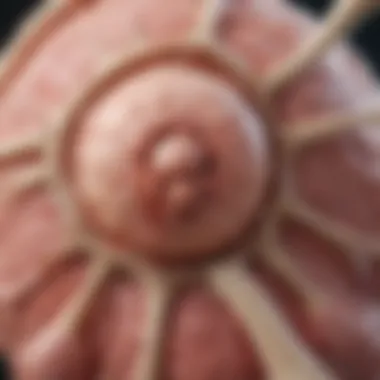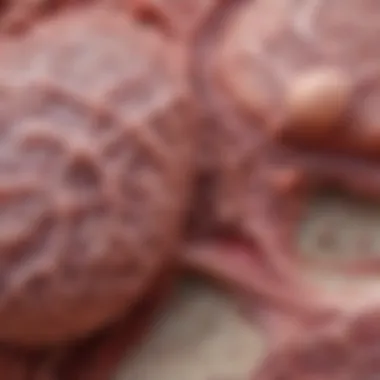Ganglion Cysts vs Giant Cell Tumors: A Comparative Study


Intro
In the medical field, understanding the distinctions between various pathologies is crucial for effective diagnosis and treatment. Ganglion cysts and giant cell tumors often present challenges for healthcare professionals due to similarities in appearance and location. However, they represent fundamentally different conditions with unique clinical implications. This analysis seeks to provide clarity on these two entities by examining their etiology, clinical features, diagnostic strategies, and management options.
Research Overview
Summary of Key Findings
Recent studies indicate differing prevalence and demographic influences for ganglion cysts and giant cell tumors. Ganglion cysts are generally more common in younger individuals, particularly athletes, while giant cell tumors are often observed in adults aged 20 to 40 years. This section will summarize contemporary research that elucidates these differences and their relevance in clinical practice.
Research Objectives and Hypotheses
The primary objective of this analysis is to delineate the distinguishing characteristics between ganglion cysts and giant cell tumors. We hypothesize that a clearer understanding of their respective profiles will aid in more accurate diagnosis and appropriate treatment strategies, reducing the potential for mismanagement.
Methodology
Study Design and Approach
This analysis employs a comparative approach, drawing on available literature and clinical data to highlight key differences and commonalities between the two conditions. By synthesizing findings from recent research, it aims to present a thorough overview of ganglion cysts and giant cell tumors.
Data Collection Techniques
Data was gathered from peer-reviewed journals, medical textbooks, and clinical guidelines available through reputable sources like Wikipedia, Britannica, and other academic platforms. This comprehensive research method ensures a well-rounded perspective on the subject matter, backed by reliable evidence.
Prelims
This article seeks to address these distinctions, providing detailed explorations into the etiology, clinical presentation, diagnostic methods, and treatment options associated with each condition. By delineating their characteristics, healthcare professionals can enhance their diagnostic acumen, thereby improving patient care. The comparison is not just academic; rather, it reflects the nuanced understanding necessary for effective evaluation and intervention, especially in orthopedic and rheumatologic contexts.
The information presented here is backed by the latest scientific research, ensuring that the reader benefits from evidence-based insights that are directly applicable in clinical settings.
Etiology
Understanding the etiology of ganglion cysts and giant cell tumors is crucial for several reasons. First, it allows healthcare professionals to recognize the underlying factors contributing to these conditions. This understanding can lead to more effective diagnostic processes, enabling timely and accurate identification of each condition. Second, recognizing the etiology of these tumors can guide treatment approaches and preventative measures, consequently influencing patient outcomes. In an orthopedic and rheumatologic context, it provides insight into how these conditions may develop in different populations and help assess risk factors involved.
Pathophysiology of Ganglion Cysts
Ganglion cysts commonly occur as fluid-filled sacs that originate from joint or tendon sheaths. The specific mechanism behind their formation is not entirely understood. They are often associated with repetitive stress or injury to the affected joint, leading to the accumulation of synovial fluid. The cysts can vary in size and may appear spontaneously or after trauma. Typically, they are benign, presenting as visible lumps under the skin, particularly around the wrist and hands.
Microscopically, ganglion cysts consist of a fibrous wall filled with a thick, translucent fluid. This fluid closely resembles synovial fluid, which typically lubricates joints. A notable aspect of ganglion cysts is their tendency to fluctuate in size. Factors such as physical activity can exacerbate their symptoms, while rest may reduce them. The cysts do not usually cause significant pain unless they compress nearby structures like nerves.
Pathophysiology of Giant Cell Tumors
Giant cell tumors of bone are notable for their aggressive behavior and potential for local recurrence. These tumors most commonly arise around the knee, particularly at the distal femur and proximal tibia. The exact etiology of giant cell tumors remains somewhat elusive, but there is evidence suggesting a correlation with hormonal influences, especially in younger adults.
At the cellular level, giant cell tumors are characterized by the presence of multinucleated giant cells, which are believed to result from the fusion of mononuclear cells. These tumors typically arise near the growth plates of long bones and are usually considered benign; however, they exhibit a higher risk of local recurrence and, in rare cases, can metastasize.


The relationship between giant cell tumors and the bone remodeling process is significant. They are often seen in areas with active bone turnover, highlighting their potential for inducing bone resorption. This aspect manifests as erosion in the surrounding bone, making early identification and proper management essential to prevent complications.
Understanding the pathophysiology of these conditions is vital for advancing treatment options and improving patient outcomes.
Clinical Presentation
Symptoms of Ganglion Cysts
Ganglion cysts may present with various symptoms that can vary in intensity. The most common indication is the presence of a visible or palpable lump, usually located near joints or tendons. These lumps are typically round or oval, and they may fluctuate in size over time. Some patients report discomfort or pain, especially when the cysts press against surrounding structures. It is important to note that many individuals experience no symptoms at all, leading them to remain unaware of the cyst's presence.
Other notable symptoms can include:
- Tenderness in the area of the cyst
- Swelling around the joint
- Limited range of motion in adjacent joints
- Symptoms worsening during activity, such as gripping or wrist movements
In some instances, the cyst could rupture, leading to localized inflammation and a temporary increase in pain or swelling. Understanding these symptoms enables more nuanced patient assessments and highlights the necessity of considering ganglion cysts when patients present with wrist or hand discomfort.
Symptoms of Giant Cell Tumors
Giant cell tumors primarily occur around the knee, but they can also affect other bones, such as the pelvis or the wrist. Patients typically report pain and swelling in the affected area. The pain often intensifies with activity, leading to a progressive functional limitation.
Additional symptoms associated with giant cell tumors include:
- Localized tenderness over the tumor site
- Decreased mobility in nearby joints
- Possible fracture of the bone due to tumor-related weakness
- Swelling that might not correspond to the degree of pain experienced
As these tumors are often benign, they may grow slowly, which can delay the recognition of the underlying issue. A thorough understanding of these symptoms is essential for effective management and treatment. The variability in symptom presentation highlights the importance of considering giant cell tumors in differential diagnoses when dealing with orthopedic complaints.
Diagnosis
The topic of diagnosis plays a pivotal role in distinguishing ganglion cysts from giant cell tumors. Accurate diagnosis is essential for effective management, which directly impacts patient outcomes. Understanding the diagnostic processes and tools aids healthcare professionals in making informed decisions. Proper differentiation of these conditions can prevent mismanagement and guide appropriate treatment pathways.
Imaging Techniques for Ganglion Cysts
Ultrasound
Ultrasound examination is a key imaging modality for evaluating ganglion cysts. Its principal characteristic is the ability to provide real-time visualization of soft tissue structures without the use of ionizing radiation. Ultrasound can effectively depict the anechoic nature of the cyst fluid, which helps in identifying ganglion cysts distinctly from solid masses. The benefits of this technique include mobility and accessibility; it can be performed in an office setting without the need for specialized facilities. However, its limitations lie in operator dependency and the challenge of distinguishing cysts from other similar-looking soft-tissue lesions.
Magnetic Resonance Imaging (MRI)
Magnetic Resonance Imaging is another valuable tool for diagnosing ganglion cysts. MRI offers high-resolution images that are particularly useful in complex anatomical areas like the wrist or ankle. The key characteristic of MRI lies in its exceptional soft-tissue contrast, making it easier to assess the relationship of a cyst to adjacent structures. MRI’s unique features include the ability to visualize both fluid and solid components, providing comprehensive information. Despite its advantages, MRI is more expensive and less accessible compared to ultrasound, which can limit its use in certain clinical situations.
Imaging Techniques for Giant Cell Tumors
Radiography
Radiography, often considered the first-line imaging modality, plays a significant role in the evaluation of giant cell tumors. The main characteristic of radiography is its utility in showing bone involvement, which is paramount in cases of giant cell tumors that typically occur in the bone. This technique is beneficial in quickly assessing for any aggressive periosteal reactions or bone destruction. However, it may be less effective for soft tissue evaluation and may miss smaller lesions, warranting further imaging studies for comprehensive assessment.


Computed Tomography (CT) Scan
Computed Tomography scans provide detailed cross-sectional images of bony structures and are invaluable when assessing giant cell tumors. The main characteristic of CT is its ability to show the extent of the tumor within the bone, along with any cortical bone involvement. CT scans are advantageous as they can quickly provide detailed information about bony lesions that plain radiography might not fully reveal. Nevertheless, CT involves exposure to radiation and is less effective at visualizing soft tissues, which might necessitate additional imaging modalities for a complete assessment.
Differential Diagnosis
Differential diagnosis is a critical aspect when evaluating ganglion cysts and giant cell tumors. These two conditions can exhibit overlapping characteristics, making it essential for healthcare professionals to accurately distinguish between them. Misdiagnosis may lead to inappropriate treatment plans, potentially worsening the patient's condition. A proper differential diagnosis not only aids in ensuring the right management approach but also helps in identifying other serious conditions that may mimic these tumors.
Conditions Mimicking Ganglion Cysts
Several conditions can imitate the presentation of ganglion cysts. Recognizing these is vital for accurate diagnosis.
- Synovial Cysts: Often found adjacent to joints, these can present similarly to ganglion cysts. They arise from the synovial lining and may cause discomfort and swelling but are usually benign.
- Tenosynovial Giant Cell Tumor: Though more aggressive, this tumor can be mistaken for a ganglion cyst due to its location and palpable mass. Imaging plays a crucial role to differentiate between the two.
- Lipomas: These benign fatty tumors can present as soft tissue masses that feel similar to ganglion cysts. They usually have a softer consistency and can be differentiated through imaging or physical exam.
- Baker's Cyst: Often occurring behind the knee, a Baker's cyst can create swelling similar to a ganglion cyst at the knee joint. Evaluation of the cyst location and characteristics is important.
Conditions Mimicking Giant Cell Tumors
Identifying conditions that could be mistaken for giant cell tumors is also important in the differential diagnosis. Here are a few noteworthy mentions:
- Aneurysmal Bone Cyst (ABC): This benign bone lesion often occurs in young individuals. With its expansile nature, it may mimic the characteristics of a giant cell tumor on imaging.
- Osteosarcoma: As an aggressive bone malignancy, osteosarcoma can show giant cells histologically, leading to misinterpretation. Differentiating features and correct imaging are crucial for diagnosis.
- Chondroblastoma: Similar to giant cell tumors, these occur most often in the epiphyseal regions of long bones. Age and location can often help in differentiating them.
"Accurate differential diagnosis is essential to avoid mismanagement that may arise from misinterpreting ganglion cysts and giant cell tumors with other conditions."
Treatment Options
Treatment options play a significant role in managing both ganglion cysts and giant cell tumors. These interventions not only aim to alleviate symptoms but also focus on preventing recurrence and maintaining patient quality of life. Understanding these options helps in making informed clinical decisions. Each treatment has distinct approaches suitable for various cases, ensuring tailored management.
Management of Ganglion Cysts
Observation
Observation is a conservative approach that involves monitoring the ganglion cyst without immediate intervention. This method is often chosen for asymptomatic cysts, as many will resolve on their own over time. The key characteristic of observation is its non-invasive nature, making it a low-risk choice for patients.
The unique aspect of this treatment is that it allows both patients and doctors to assess the cyst's natural course. In many cases, it may decrease in size or completely disappear, which is beneficial for a number of individuals who prefer to avoid unnecessary procedures. However, if the cyst causes discomfort or limitations in daily activities, a different management strategy may then be pursued.
Aspiration
Aspiration involves using a needle to drain the fluid from the ganglion cyst. It is a beneficial procedure because it can relieve symptoms quickly and is less invasive than surgery. The aspiration technique is characterized by its simplicity and effectiveness for symptomatic cysts.
The unique feature of aspiration is that it can provide immediate relief for the patient. In addition to reducing the size of the cyst, it may also prevent the need for more invasive procedures. However, one should note that cysts can re-accumulate fluid after aspiration, making this option sometimes a temporary solution rather than a permanent fix.
Surgery
Surgery is usually considered when other treatments have failed, especially for persistent or painful ganglion cysts. Surgical resection involves completely removing the cyst and its stalk from the underlying tissue. This method is beneficial as it provides a definitive way to eliminate the cyst and reduce the likelihood of recurrence.
The key characteristic of surgery is that it directly addresses the root cause of the symptoms. Furthermore, it allows for examination of the surrounding tissues, which can help in diagnosing any potential complications. However, surgery comes with higher risks, such as infection and prolonged recovery time, which must be weighed against the potential benefits.


Management of Giant Cell Tumors
Surgical Resection
Surgical resection is the primary treatment for giant cell tumors due to their locally aggressive nature. This procedure involves excising the tumor entirely to prevent recurrence and damage to surrounding structures. Surgical resection is crucial in managing this condition and greatly impacts the patient's long-term outcome.
The key characteristic of surgical resection is that it aims for complete removal of the tumor, reducing the risk of recurrence significantly. This approach is often favored when the tumor is localized and has not invaded surrounding tissues. However, the surgery may result in loss of function in the affected area, making rehabilitation necessary for recovery.
Adjunctive Therapies
Adjunctive therapies, such as the use of medications or radiation therapy, are often implemented following significant surgical intervention. These therapies aim to help in reducing the risk of recurrence and managing post-surgical complications. A key characteristic of these treatments is their role in comprehensive care, addressing not just the tumor itself but supporting overall recovery.
The unique aspect of adjunctive therapies is that they can include various modalities. For example, corticosteroids may be used to help control inflammation after surgery. However, not all patients may respond to these therapies, which can sometimes delay healing or complicate rehabilitation.
Prognosis
The prognosis of ganglion cysts and giant cell tumors provides critical insight into the long-term outcomes and possible complications associated with each condition. Understanding the prognosis is essential for both patients and healthcare professionals. It influences treatment approaches and informs expectations regarding recovery and recurrence rates. This section delineates the varied prognoses associated with ganglion cysts and giant cell tumors, which can inform clinical decisions and patient education.
Outcomes for Ganglion Cysts
Ganglion cysts generally have a favorable prognosis. In many cases, these fluid-filled sacs resolv without intervention. Key aspects of the prognosis include:
- Natural Resolution: A significant proportion of ganglion cysts, particularly those that are asymptomatic, may resolve spontaneously.
- Recurrence: Even after surgical excision, some ganglion cysts may recur. This aspect is particularly relevant for patients who may experience repeated symptoms.
- Symptoms Management: For symptomatic cysts, aspiration can provide temporary relief, but the cyst may refill. Long-term management focuses on symptoms rather than removing the cyst completely. While surgery is effective, it does carry risks, including potential nerve damage or infection, which can affect prognosis.
Outcomes for Giant Cell Tumors
The prognosis for giant cell tumors is more complex due to their aggressive nature and potential for recurrence. Important considerations include:
- Surgical Success: Surgical resection is often necessary. The outcome heavily depends on the tumor's location and the completeness of the excision. Incomplete removal can lead to persistent or recurrent disease.
- Recurrence Rates: Giant cell tumors are known for their recurrence rates, which can be as high as 50%. This emphasizes the need for ongoing surveillance post-surgery.
- Impact of Adjunctive Therapies: Newer adjunctive therapies such as targeted therapies can improve prognosis by reducing recurrence risk in some patients. Further research is ongoing to establish optimal strategies.
The prognosis for ganglion cysts tends to be more favorable compared to giant cell tumors, emphasizing the need for tailored treatment based on individual case characteristics.
Overall, the prognosis varies significantly between these two conditions. Understanding these nuances assists healthcare professionals in guiding treatment plans and managing patient expectations.
The End
The conclusion serves a critical role in synthesizing the various aspects of ganglion cysts and giant cell tumors addressed in this article. It consolidates vital information that healthcare professionals, including students and researchers, need when navigating these conditions.
Summary of Key Differences
Understanding the distinct characteristics between ganglion cysts and giant cell tumors is essential for accurate diagnosis and appropriate treatment. Below are some key differences:
- Cause: Ganglion cysts are typically related to joint or tendon issues, whereas giant cell tumors arise from bone tissue and are often associated with trauma or previous injury.
- Location: Ganglion cysts are usually found near joints or tendons, particularly in the wrist and hand. In contrast, giant cell tumors mostly occur in the epiphysis of long bones, especially around the knee.
- Presentation: Symptoms for ganglion cysts may include localized swelling and discomfort, while giant cell tumors often present with pain and swelling related to joint movement.
Implications for Clinical Practice
Recognizing the differences between these two conditions holds significant implications for clinical practice. Accurate diagnosis directly impacts treatment choices. Misdiagnosing a giant cell tumor as a ganglion cyst could lead to insufficient management. Therefore, healthcare providers must be vigilant about the possibility of giant cell tumors in patients presenting with bone-related symptoms.
Additionally, the treatment protocols differ considerably between the two, influencing patient outcomes. Being aware of these variances enhances the ability of clinicians to offer individualized care, leading to better prognoses. Effective management involves not just addressing the symptoms but also understanding the underlying pathology.
"Clinicians must cultivate a deep understanding of both conditions to ensure optimal treatment pathways are chosen for patients."
Incorporating evidence-based approaches to these conditions improves clinical decision-making and can significantly enhance patient care. The role of continuous education on the characteristics of ganglion cysts and giant cell tumors is essential in promoting effective clinical management.















